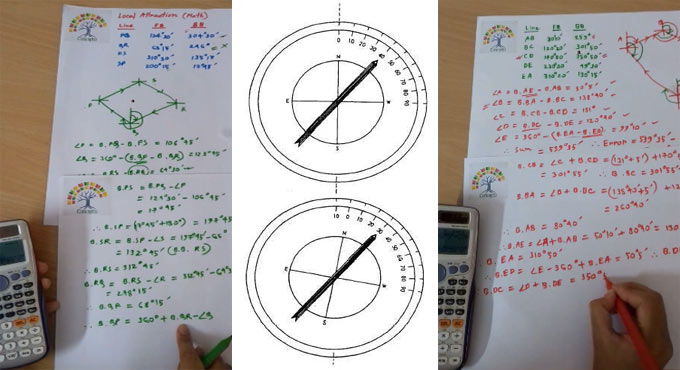
Local Attraction in Compass Surveying
A compass shows the direction of the magnetic summit on the basis of magnetism and when any magnetic attracting material is brought near the compass needle, the needle will divert from the right magnetic north. Materials which will be present there in the time of the compass surveying, like iron chain, metallic waist band, electric wires etc. can produce local attraction and will attract the needle and will divert from the true direction of the magnetic summit.
If any local attraction is available at a station, then all the readings taken from that station will show similar errors and it is a need to correct the readings to get the right results. It is a miracle thing that helps the magnetic needle continuously restrained to point towards the magnetic north at a place as these magnetic compass is attracted by other magnetic things at that locality like electric wires, rails, steel and iron structures, steel tapes etc.
The incidence of local attraction can be identified by watching the difference between the front and back bearings and it will be 180 without the effect of local attraction.
Removing elimination of local attraction in surveying of compass: The local attractions generally make the mistakes and these errors are seen in the time of compass surveying observations which remain same on all bearings. There are some ways to get the corrections which are applied on the incorrect readings in the traversing which are discussed in the below:
1) The first method is depended on the difference of front and back bearings; it is important to find out the stations where no local attraction is there and to look for a line where the difference is exactly equal to 180?. As per this error free observation of bearings, corrections for other lines will be calculated and if such line can be fined then the two end stations of that line are free from any local attraction and will be applied to the bearings of the other lines.
2) Second method is faster to apply correction and it is depended on the internal angles of the closed cross formed and these angles measured will be correct on the base as these angles are not affected by the local attraction and nearby stations. When there is any error between both sums they will not become same then the total error can be scattered among the angles equally as same error will be seen on each interior angle.
3) Method three is applied on special case when there exists no such observations which has a difference of 180?in front and back bearings of a line; then least difference between two bearings is selected in a way that this difference of them is next to 180?. The basic value is acquired by adding half of the correction to fore bearing unit and half to back bearing.
Magnetic field of Earth: We all know that our earth is the most powerful magnet with a magnetic field around it where the lines of force are from south to north and if a bar magnet is freely dangled it will align itself parallel to the lines of magnetic force of earth. Meanwhile the horizontal bulges of these lines will become magnetic meridian.
Angle of dip and Compass survey: The angle between the lines and earth?s exterior is known as dip or angle of dip and the lines of force of magnetic field is always faced towards north in Northern hemisphere and inclined towards south in Southern hemisphere. The area is called North Magnetic Pole where the dip is 90?, north latitude is 70? and west longitude is 96? similarly there is also a South magnetic pole; the dip of the magnetic needle will be 0 and all other points dip will be acting downwards.
Magnetic denial and Compass survey: It is known as the horizontal angle between the true meridian and the magnetic meridian which is indicated by the magnetic needle of the compass. When the magnetic meridian is turned to the right or eastern side it is called positive and when it is on the left or true meridian called negative.
Isogonic line and Compass survey: It is drawn to connect all points of same declination for the unusual variation of in earth?s magnetic field not making any complete circles but from north to south they are drawn with unusual paths.
To learn the local attraction in compass surveying, go through the following link engineeringcivil.org


